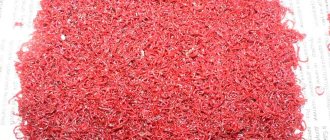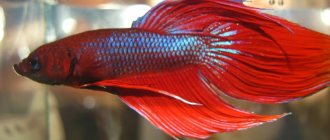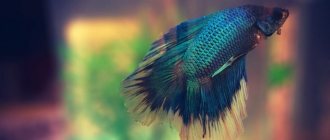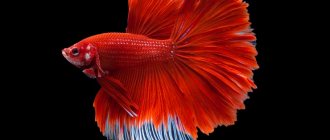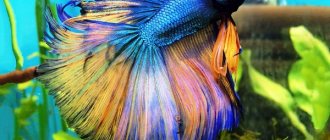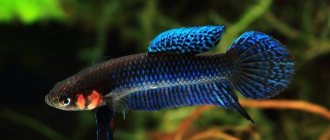Simplicity of content:
Latin name: Betta splendens
Lifespan: 3 years
Maximum size: 7 cm.
Average cost: from 150 rub.
The betta fish is known by many names: Betta, Siamese betta, betta fish. All these names imply a small fish of the macropod family.
King betta and other types of betta fish
The cockerel fish, Siamese cockerel, or fighting fish (lat. Betta splendens) is a representative of the Macropod family, suborder Labyrinthidae. Betta fish are found in freshwater bodies of standing water in Southeast Asia.
Nowadays, breeding forms of cockerels often become participants in international exhibitions. They first learned about the cockerel fish in the 19th century, when the inhabitants of Siam found it in rice ditches. Noticing the aggressive nature towards their relatives, people gave the fish to the local ruler. European naturalists who visited Siam examined its features. Later, with her participation, “cockfights” were organized, for which the fish was nicknamed “fighting fish”. Cockerels were brought to Europe in 1892. At the beginning of the twentieth century, American breeders began to breed new species of Betta splendens, which were distinguished by fins of unusual symmetry and richly colored scales.
general description
About the varieties of these fish according to the shape of the caudal fin and color
Popular aquarium representatives
AkvariumnyeRybki.ru>
Diseases
Siamese bettas are strong fish; they most often get sick from improper care. Due to the low water temperature in the aquarium, their immunity weakens. They become susceptible to diseases.
- Semolina;
- Dropsy;
- Costiosis;
- Fin rot.
All of these diseases have fatal potential, but are treatable in the early stages. Table salt, mytelena blue, antibacterial and other medicines can save your pet. Add to the medical treatment the complete disinfection of the aquarium, plants, equipment and decor, and perhaps luck will smile on you. However, prevention is a much more reliable method. Follow the care rules described above, and your fish will live a long, carefree life!
Betta fish: care and maintenance
Cockerels are unusual, incredibly bright and exotic fish. Aquarists love them very much not only for their beautiful appearance, but also for their fighting character. However, in order for these fish to please their owners for a long time, they need special care. This article contains information regarding the features of keeping and breeding cockerels in an aquarium.
Origin
Southeast Asia is considered the birthplace of the betta fish. Its main habitats are warm, fresh, slow-flowing or stagnant bodies of water in Thailand, Vietnam, the Malay Peninsula and the islands of Indonesia.
The first mention of this unusual fish occurs in history in 1800. At that time, the inhabitants of Siam (now Thailand) noticed the increased aggressiveness of the males of this fish towards each other and began breeding a special breed for fights with monetary stakes.
Cockerels were introduced to Europe in 1892. The first countries to see the miracle fish were France and Germany. They came to the USA in 1910, where Frank Locke developed a new color version of the cockerels. In Russia, the history of their appearance is associated with the names of V.M. Desnitsky and V.S. Melnikov and date back to 1896.
Compatibility
Reproduction
Diseases
Interesting Facts
- In South Asia, cockerels were used for fighting with money stakes. Fights, as a rule, did not lead to the death of fish; it ended with frayed tails. Now such fights are prohibited.
- A male cockerel can fight until he is completely exhausted even with his reflection in the mirror.
- These fish are endowed with two respiratory systems: gills and a labyrinth organ.
- Cockerels show sympathy for the opposite sex in a very interesting way: the female “fidgets” back and forth, and the male protrudes his gills and fins and wriggles his whole body.
Useful tips
You should not pet your bettas too often (although they allow it), as some owners do. The scales have a protective layer of mucus on top. If this film is accidentally damaged, the fish will become very vulnerable to various diseases.
Sometimes bettas can lie down on the bottom of the aquarium. If this does not last long, then there is no need to worry - this is how they rest. The alarm should be raised if this behavior has been observed for a long time. Then you need to contact a specialist and check the health of the fish.
If the fish are sick, there are special medications to treat them (antifungi or parasites, antibiotics). It is better to order them at the pet store in advance.
We hope that this article was useful for those who are planning to place a betta fish in their aquarium. Let your pet feel comfortable and enjoy its beauty for a long time!
And according to tradition, a video that talks about the rules of care and maintenance of a Siamese cockerel:
aquariumguide.ru>
Description and varieties
Betta fish (betta, Siamese betta, Betta splendens) is a species of fish that belongs to the macropod family. This is a labyrinth fish that also uses atmospheric air for breathing.
The body shape of cockerels is oval, it is flattened laterally and elongated in length. The sizes of the fish are mostly small: males are about 5 cm, and females are 4 cm. However, there are individuals that can reach 10 cm in length. The caudal and upper fins are rounded, the pectoral fins are pointed. The fins of males are longer than those of females.
Cockerels have very interesting and varied colors. They come in one, two or multi-colors. The color can contain all the colors of the rainbow, as well as their shades. Males are brighter colored than females.
The brightness of the color is affected not only by lighting, but also by the condition of the fish: during spawning or skirmishes with their own kind, male bettas become the brightest.
The lifespan of a betta fish is approximately three years.
To date, breeders have bred about 70 species of cockerels. All of them have a bright unusual color. There are several classifications of species.
Depending on the fin shape and size:
- veiled;
- crescent-tailed;
- crown-tailed;
- two-tailed;
- round-tailed;
- delta-tailed;
- brush-tailed;
- flag-tailed;
- poster;
- royal.
Depending on the color:
- plain;
- two-color;
- multicolor.
How to equip an aquarium?
Betta fish are considered unpretentious and easy to care for, but some conditions must be met.
Volume
Bettas can be kept in both small (10-15 l) and large aquariums. One individual requires 3-4 liters of water. If the aquarium is large, then it can be divided into several parts by partitions. In this case, several males can be kept in one container at the same time without compromising their health.
The partitions are made of transparent non-toxic material with small holes for water circulation. It is better to plant tall plants next to them to block the fish’s view and reduce unwanted encounters.
Cockerels are capable of jumping quite high out of the water, so the top of the aquarium is equipped with a mesh or lid with holes for air passage
Water
Air
The cockerel is a labyrinth fish, that is, it breathes not only with gills, but also with an additional special organ. In it, the blood is saturated with air, which the fish captures with its mouth. Therefore, aeration is not very important for cockerels, but it is advisable to install a filter. It can be of low power, since these fish do not like strong currents.
It is also important that the surface of the water is not completely overgrown with plants, so that the betta can rise to the surface and take in air. Sometimes it happens that a bacterial film forms on the surface of the water. It needs to be removed. This can be done using a sheet of paper, placing it on the surface of the water, and then removing it along with the film.
Priming
Plants
Decorations and lighting
Nutrition
Cockerels are not picky eaters and are practically omnivorous. You can use live, dry and frozen food for them. Nevertheless, the majority of the diet should be live food (bloodworms, tubifex, daphnia, cyclops, etc.). Cockerels will not refuse earthworms or flatworms, snails or zooplankton.
Feed the fish 1-2 times a day. Just enough food is given at one time so that the fish eat it completely in 15 minutes. Remains must be removed immediately. Overfeeding is not recommended, as this can lead to obesity in the fish. It’s good to have a fasting day once a week.
The fish are sleeping, they are tired. How do fish sleep?
Oh those stereotypes
How do fish sleep?
You can understand that a fish has fallen asleep by the following signs: it froze in a thicket or other secluded place, or hovered in the water column. Some can even lie down, and some species prefer to rest on their sides.
Most species of fish prefer to sleep in the dark, so if you go to the aquarium and turn on the light, you will be able to notice how its inhabitants return to an alert state and wake up. But there are also those who rest during the day. These are predator fish, such as catfish.
However, fish sleep is not the state that is meant by this word in people. How do fish sleep? For them, this is not a state of complete relaxation and unconsciousness, like you and I, but rather a process of slowing down vital functions. This allows the fish to become active very quickly if something dangerous or edible appears nearby.
The deep sleep phase, in which there is an almost complete loss of contact with reality, is absent in fish. However, during sleep the nervous system and other body functions are restored.
Do all fish sleep the same?
Why do you need to know about the sleep habits of fish?
It is important to know how fish sleep not only to satisfy your own curiosity, but also to provide the fish with comfortable living conditions. Like people, they don’t like it if their routine is violated and they can suffer from insomnia, therefore:
- be sure to turn off the lights in the aquarium at night;
- select the fish so that they sleep at the same time of day.
Please note that there are species of fish that sleep during the day and prefer thickets for this. If you place these in your aquarium, then during the daytime it will look empty and uninteresting.
fb.ru>
Historical background
This aquarium fish has been known since the late 18th – early 19th centuries. Observant residents of Siam noticed the strange nature of the inhabitants of stagnant rivers, who showed aggressiveness for no reason. They fought each other aggressively and harshly, to the point of jumping out of the water and sacrificing themselves. These were the microfighters, called Siamese fish - cockerels.
Later, in the imperial palace, the appreciation of their originality increased even more. To the extent that famous people become interested in fish fights, including those with quite significant stakes. The betta fish has received recognition and honor.
Much has changed since those times. For example, a visual image. The classic specimen looks discreet: gray-silver color, longitudinal dark stripes from head to tail, elongated body flattened laterally and large rounded fins.
Who do betta fish get along with in a community aquarium?
Today, bettas (lat. Betta splendens) are popular aquarium fish. They belong to the Macropod family, suborder Labyrinth fish. Cockerels have a cocky character, for which they are nicknamed “fighting fish.” They do not always tolerate settlements with other fish; it is difficult for them to live with neighbors due to their pugnacity. If you place a male betta in the same aquarium with another betta, then conflicts will arise between them, which will end in bodily harm and plucked fins.
But this does not mean at all that they cannot be housed with fish. On the contrary, a good neighborhood harmonizes life in the aquarium. If your tank is spacious, has a beautiful aquascape created in it, reminiscent of a natural biotope, there are a lot of plants, shelters, and a biological balance has been established - then all the inhabitants will be comfortable. An important rule is that you cannot have more than one male betta living within the same aquarium. They cannot be called territorial fish, but it so happens that they will fight. You can house several females for one male, so he will be comfortable.
Female Betta splendens are smaller in size, their fins are shorter, and their character is calmer. But females can also conflict both with each other and with the male. Females can be kept in one nursery of 3-4 individuals. They are less aggressive, but their character is also unpredictable. If you notice that betta fish are constantly aggressive towards their neighbors, and this leads to fatal consequences, then do not spare money for another tank, placing a restless pet in it.
Rules for keeping Betta splendens in a common tank
These fish tolerate temperature changes well and can thrive at temperatures of +18 and +25 degrees Celsius. But sudden changes should not be allowed, as they are harmful to the pet’s health. Like a labyrinth fish, the betta should live in water that corresponds to the ambient air temperature in the room: +22-26 degrees. Due to the fact that he can breathe with a labyrinth organ, aeration is not necessary - this should be taken into account when introducing other fish that cannot live without dissolved oxygen. The water must be replaced once a week, 20% of the total volume of the tank. Don't forget to clean the bottom of food debris and dirt.
What rules must be followed so that bettas can live peacefully in an aquarium with other fish? These rules apply to all cockerels, thanks to which peaceful cohabitation with representatives of different species of fish can be achieved.
- It is not recommended to keep fish with long fins and brightly colored scales with bettas. Although the cockerels themselves are distinguished by their beautiful appearance, they are sensitive to “competitors” who are like external irritants for them.
- You cannot house cockerels with large and predatory fish, for example, African and South American cichlids. The latter themselves are peaceful and friendly creatures, but they do not get along with fighting fish.
- Try to keep your fish in water that is suitable for everyone. It is impossible to settle heat-loving species and cold-loving ones. For example, goldfish cannot live in warm water, so they are incompatible with betta fish.
- Betta splendens fish can be housed with speckled catfish, tetras, gouramis, swordtails, and mollies. After settling the fish in the aquarium, observe their behavior. You can also keep the fish together from a young age, so they will get used to each other better. Fish should not be less than 5 cm in length. If your neighbor's fish has died, do not add a new fish to the cockerel, otherwise he will kill it.
- Compatibility with other fish will be successful if the betta lives in a spacious tank of 50-100 liters. You can put a lot of decor and shelters there, which will nullify territorial claims and conflicts.
Take a look at a community aquarium with bettas.
There are aquarium fish with which bettas are well compatible; they live peacefully, with periodic fights that do not lead to death. These fish include marbled gourami, cardinals, labeo, lalius, macrognathus, and angelfish. But it should be taken into account that during the first days of settlement it is necessary to monitor their reaction; in case of aggression, they are settled separately from each other.
The fish Betta splendens has almost perfect compatibility with platies, iridescents, black mollies, ornathuses, grumbling gouramis, acanthophthalmus, befortia, ancistrus, minors, otocincles, rasboras, thorns, congos, botias, tarakatums, loricarias, Siamese gastromyzons, brocade catfishes.
Description of compatibility with certain fish species
AkvariumnyeRybki.ru>
Reproduction
Males are ready for breeding at the age of 6-8 months. The fish are able to build a nest in a community aquarium. But to obtain offspring, you need to use a spawning tank with a volume of 4–5 liters, where you can pour water to a height of 10–15 cm. You need to place more vegetation in the aquarium. The temperature should be +28°C. No aeration required. Avoid exposure to bright light.
The male cockerel plays the main role in reproduction.
So, the reproduction process has the following features:
- First, the male is placed in the aquarium. He begins to build a nest of air bubbles, which he treats with his own saliva, so that they do not burst.
- A day later, the female is placed. After a few days, spawning can be observed.
- If this does not happen, try replacing the female. You can simulate spawning by adding fresh water. If the male shows aggression, he should be changed.
- The female produces eggs, which the cockerel fertilizes. He collects them and puts them in a prepared place.
- The male takes care of the eggs. He returns them to the nest if they fall out, and removes the dead. The number of eggs varies from 200 to 400 pieces.
- After 24–48 hours, the larvae will appear. After 4–6 days they will become fry and begin to swim. At this time, the male is removed from the spawning aquarium. Otherwise, in his attempts to return the fry to the nest, he may crush them.
- Now you should install aeration in the container - blowing air through the water. At first, the fry are not able to cope without oxygen in the aquarium water. The labyrinthine organ will appear in them only after a few months.
- During the first days of life, the fry are fed ciliates. If such food is not available, you can use egg yolk. After a few days, Artemia larvae are added to the diet.
Important! After completion of spawning, the female is immediately removed, since the males show their aggressive nature even during this period.
